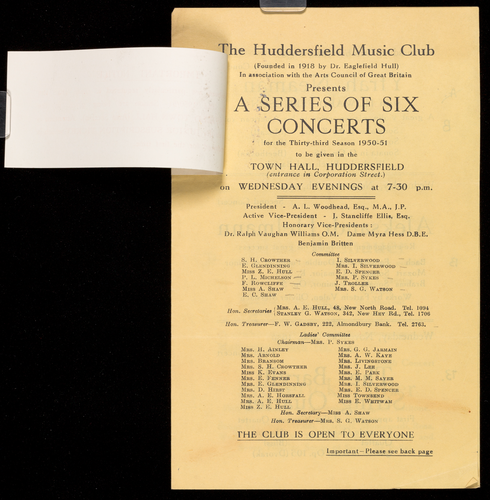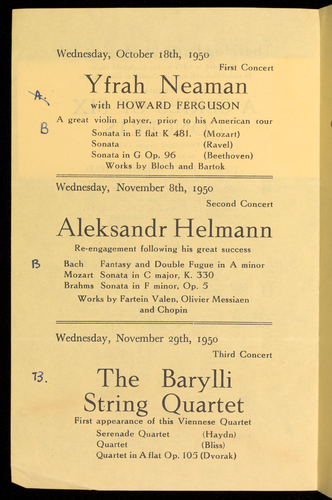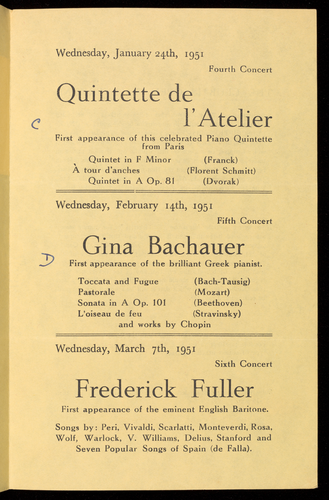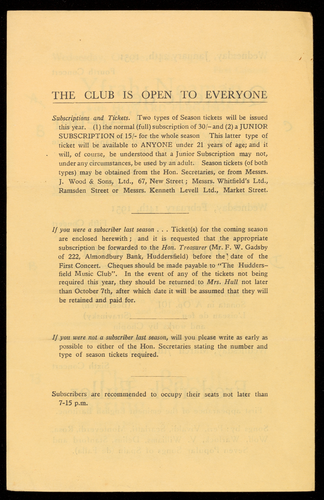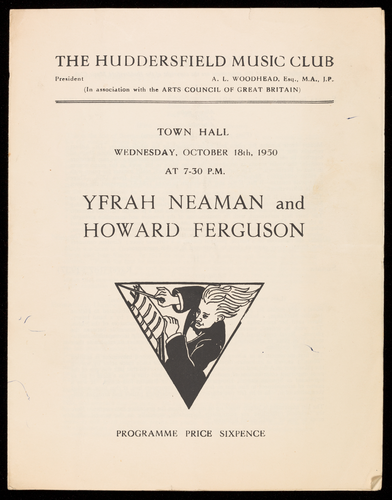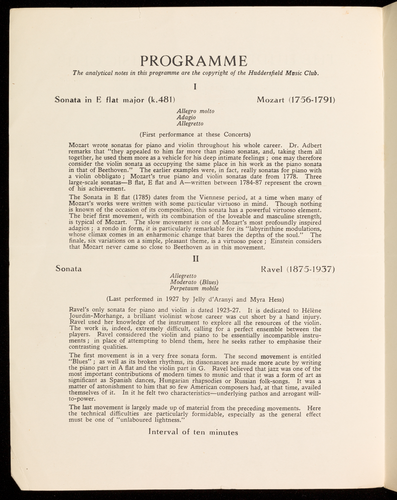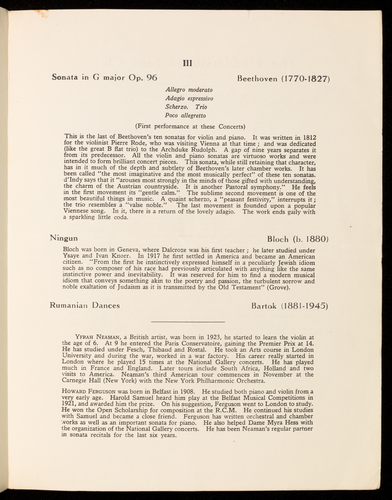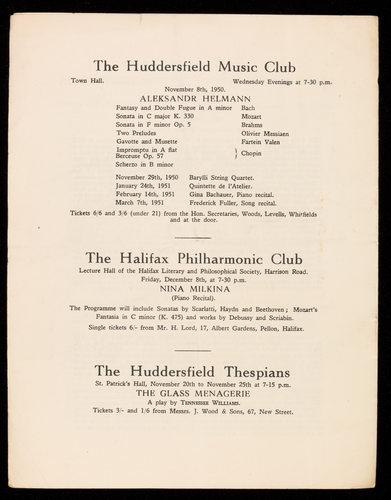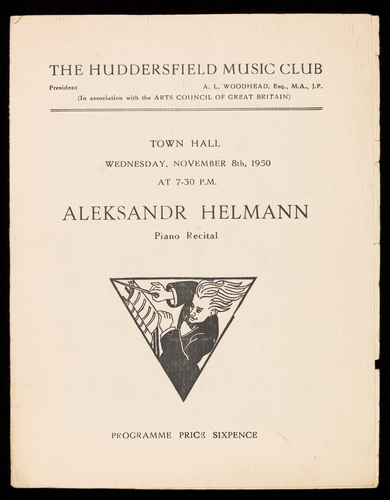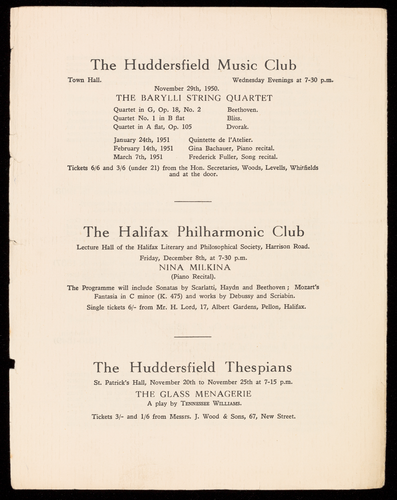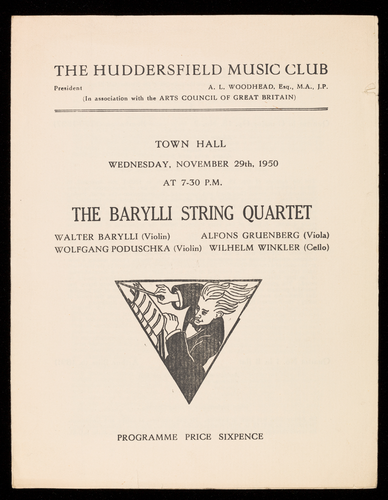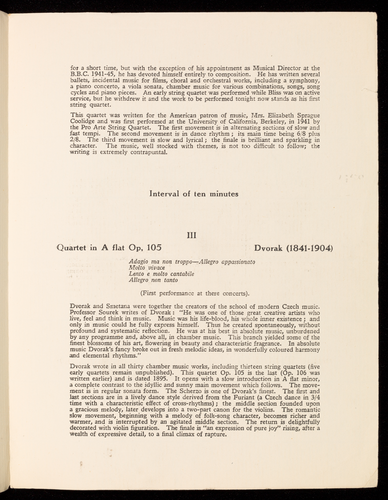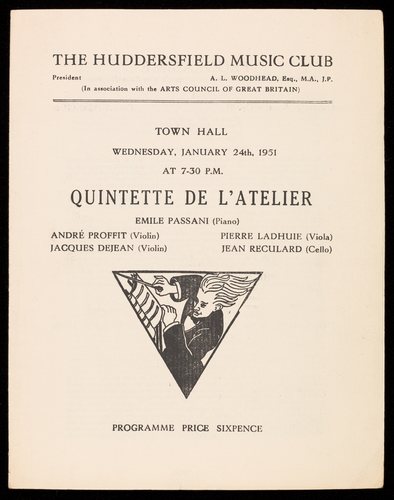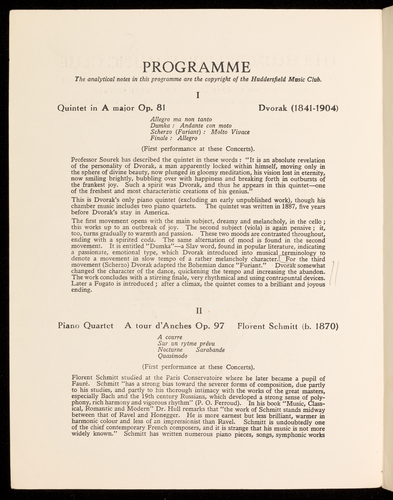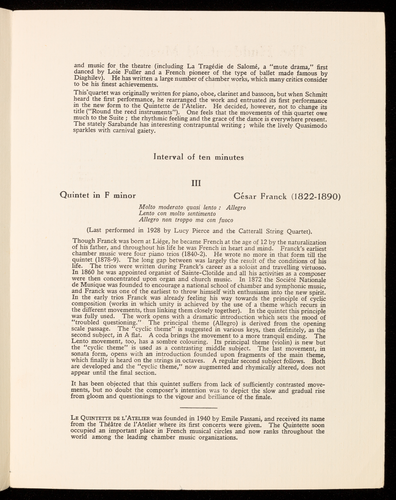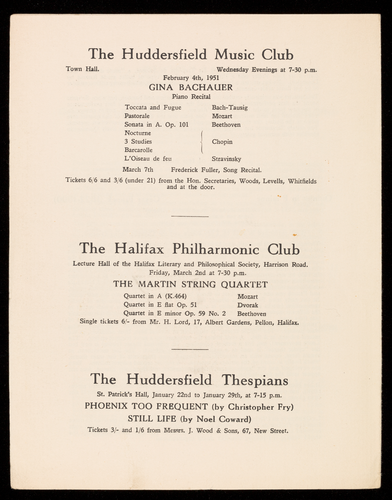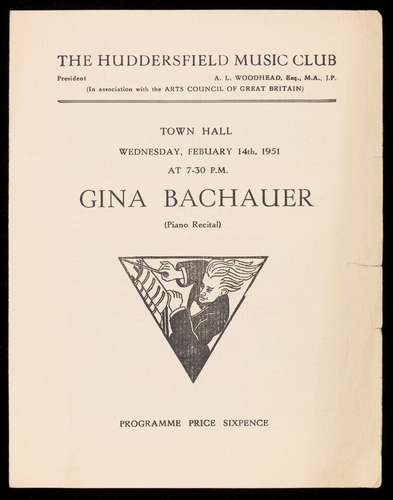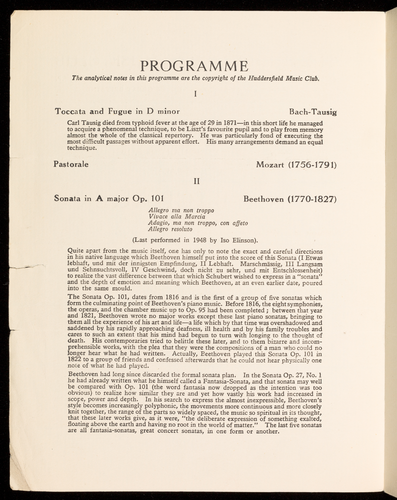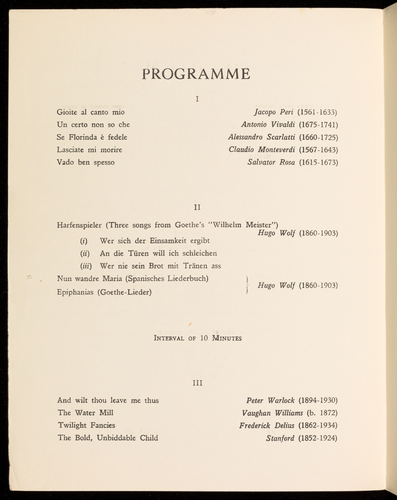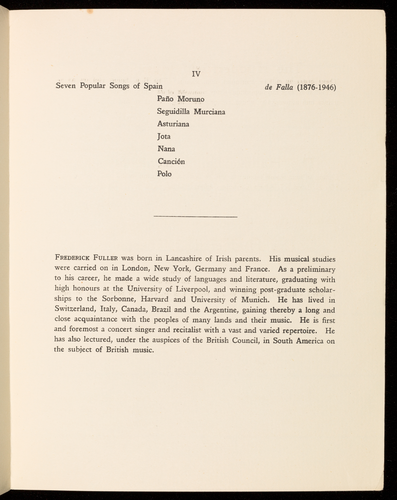Ocr'd Text:
The Huddersfield Music Club
IMPORTANT NOTICE
Subscribers are particularly requested to note that the
Recitals for the 1950/51 Season are being given in the
HUDDERSFIELD TOWN HALL (Area Section). Attention is
also drawn to the JUNIOR SUBSCRIPTION TICKET which is
being introduced for the first time.
1950-63
on
poro
WEDNESDAY EVENINGS
President A. L. Woodhead, Esq., M.A., J.P.
Active Vice-President - J. Stancliffe Ellis, Esq.
Honorary Vice-Presidents :
Dr. Ralph Vaughan Williams O.M. Dame Myra Hess D.B.E.
Benjamin Britten
PD
S. H. CROWTHER
E. GLENDINNING
MISS Z. E. HULL
P. L. MICHELSON
F. RowCLIFFE
MISS A. SHAW
E. C. SHAW
1
MRS. H. AINLEY
MRS. ARNOLD
MRS. BRANSOM
MRS. S. H. CROWTHER
EVENINGS at
MISS K. EVANS
MRS. E. FENNER
MRS. E. GLENDINNING
MRS. D. HIRST
MRS. A. E. HORSFALL
MRS. A. E. HULL
MISS Z. E. HULL
Committee
MRS. A. E. HULL, 48, New North Road. Tel. 1094
Hon. Secretaries STANLEY G. WATSON, 342, New HEY Rd., Tel. 1706
Hon. Treasurer-F. W. GADSBY, 222, Almondbury Bank. Tel. 2763.
Ladies' Committee
Chairman-MRS. P. SYKES
7-30
at 7-30 p.m.
a
I. SILVERWOOD
MRS. I. SILVERWOOD
E. D. SPENCER
MRS. P. SYKES
J. TROLLER
MRS. S. G. WATSON
MRS. G. G. JARMAIN
MRS. A. W. KAYE
MRS. LIVINGSTONE
MRS. J. LEE
MRS. E. PARK
MRS. M. M. SAYER
MRS. I. SILVERWOOD
MRS. E. D. SPENCER
MISS TOWNSEND
Miss E. WHITWAM
Hon. Secretary-MISS A. SHAW
Hon. Treasurer-MRS. S. G. WATSON
THE CLUB IS OPEN TO EVERYONE
Testi)
S
Important Please see back page
V
Ocr'd Text:
The Huddersfield Music Club
(Founded in 1918 by Dr. Eaglefield Hull)
In association with the Arts Council of Great Britain
Presents
A SERIES OF SIX
CONCERTS
for the Thirty-third Season 1950-51
to be given in the
TOWN HALL, HUDDERSFIELD
(entrance in Corporation Street.)
on WEDNESDAY EVENINGS at 7-30 p.m.
President A. L. Woodhead, Esq., M.A., J.P.
Active Vice-President J. Stancliffe Ellis, Esq.
F9
Honorary Vice-Presidents :
Dr. Ralph Vaughan Williams O.M. Dame Myra Hess D.B.E.
Benjamin Britten
S. H. CROWTHER
E. GLENDINNING
MISS Z. E. HULL
P. L. MICHELSON
F. RowCLIFFE
MISS A. SHAW
E. C. SHAW
MRS. H. AINLEY
MRS. ARNOLD
MRS. BRANSOM
MRS. S. H. CROWTHER
MISS K. EVANS
Hon. Secretaries
MRS. A. E. HULL, 48, New North Road. Tel. 1094
STANLEY G. WATSON, 342, New HEY Rd., Tel. 1706
Hon. Treasurer-F. W. GADSBY, 222, Almondbury Bank. Tel. 2763.
Ladies' Committee
Chairman-MRS. P. SYKES
MRS. E. FENNER
MRS. E. GLENDINNING
Committee
MRS. D. HIRST
MRS. A. E. HORSFALL
MRS. A. E. HULL
MISS Z. E. HULL
I. SILVERWOOD
MRS. I. SILVERWOOD
E. D. SPENCER
MRS. P. SYKES
J. TROLLER
MRS. S. G. WATSON
8.
MRS. G. G. JARMAIN
MRS. A. W. KAYE
MRS. LIVINGSTONE
MRS. J. LEE
MRS. E. PARK
MRS. M. M. SAYER
MRS. I. SILVERWOOD
MRS. E. D. SPENCER
MISS TOWNSEND
MISS E. WHITWAM
Hon. Secretary-MISS A. SHAW
Hon. Treasurer-MRS. S. G. WATSON
THE CLUB IS OPEN TO EVERYONE
TOBITE
TAUS
Important- Please see back page
8
Ocr'd Text:
B
Wednesday, October 18th, 1950
Yfrah Neaman
with HOWARD FERGUSON A
B
A great violin player, prior to his American tour
Sonata in E flat K 481.
Sonata
Sonata in G Op. 96 o: (Beethoven)
Works by Bloch and Bartok
13.
First Concert
isiones ni
(Mozart)
(Ravel)
Wednesday, November 8th, 1950
Second Concert
Aleksandr Helmann
Re-engagement following his great success
Bach
Fantasy and Double Fugue in A minor
Mozart Sonata in C major, K. 330
Brahms Sonata in F minor, Op. 5
Works by Fartein Valen, Olivier Messiaen
and Chopin
Wednesday, November 29th, 1950
Third Concert
The Barylli
String Quartet
First appearance of this Viennese Quartet
Serenade Quartet
(Haydn)
Quartet
(Bliss)
Quartet in A flat Op. 105 (Dvorak)
Ocr'd Text:
с
Wednesday, January 24th, 1951
D
Quintette de
l'Atelier
First appearance of this celebrated Piano Quintette
from Paris
(Franck)
(Florent Schmitt)
Quintet in F Minor
À tour d'anches
Quintet in A Op. 81
Wednesday, February 14th, 1951
Fourth Concert
Toccata and Fugue
Pastorale
Sonata in A Op. 101
L'oiseau de feu
Gina Bachauer
First appearance of the brilliant Greek pianist.
(Dvorak)
Wednesday, March 7th, 1951
Fifth Concert
(Bach-Tausig)
(Mozart)
(Beethoven)
(Stravinsky)
and works by Chopin
Sixth Concert
Frederick Fuller
First appearance of the eminent English Baritone.
Songs by: Peri, Vivaldi, Scarlatti, Monteverdi, Rosa,
Wolf, Warlock, V. Williams, Delius, Stanford and
Seven Popular Songs of Spain (de Falla).
Ocr'd Text:
1001
nunc
combo W
THE CLUB IS OPEN TO EVERYONE
Subscriptions and Tickets. Two types of Season tickets will be issued
this year. (1) the normal (full) subscription of 30/- and (2) a JUNIOR
SUBSCRIPTION of 15/- for the whole season This latter type of
ticket will be available to ANYONE under 21 years of age; and it
will, of course, be understood that a Junior Subscription may not,
under any circumstances, be used by an adult. Season tickets (of both
types) may be obtained from the Hon. Secretaries, or from Messrs.
J. Wood & Sons, Ltd., 67, New Street; Messrs. Whitfield's Ltd.,
Ramsden Street or Messrs. Kenneth Levell Ltd., Market Street.
ce di visi
ho
If you were a subscriber last season... Ticket(s) for the coming season
are enclosed herewith; and it is requested that the appropriate
subscription be forwarded to the Hon. Treasurer (Mr. F. W. Gadsby
of 222, Almondbury Bank, Huddersfield) before the date of the
First Concert. Cheques should be made payable to "The Hudders-
field Music Club". In the event of any of the tickets not being
required this year, they should be returned to Mrs. Hull not later
than October 7th, after which date it will be assumed that they will
be retained and paid for.
(valen
If you were not a subscriber last season, will you please write as early as
possible to either of the Hon. Secretaries stating the number and
type of season tickets required.
Subscribers are recommended to occupy their seats not later than
7-15 p.m.
slugo't novel.
Ocr'd Text:
THE HUDDERSFIELD MUSIC CLUB
A. L. WOODHEAD, Esq., M.A., J.P.
President
(In association with the ARTS COUNCIL OF GREAT BRITAIN)
TOWN HALL
WEDNESDAY, OCTOBER 18th, 1950
AT 7-30 P.M.
YFRAH NEAMAN and
HOWARD FERGUSON
PROGRAMME PRICE SIXPENCE
Ocr'd Text:
PROGRAMME
The analytical notes in this programme are the copyright of the Huddersfield Music Club.
I
Sonata in E flat major (k.481)
Allegro molto
Adagio
Allegretto
(First performance at these Concerts)
Mozart wrote sonatas for piano and violin throughout his whole career. Dr. Adbert
remarks that "they appealed to him far more than piano sonatas, and, taking them all
together, he used them more as a vehicle for his deep intimate feelings; one may therefore
consider the violin sonata as occupying the same place in his work as the piano sonata
in that of Beethoven." The earlier examples were, in fact, really sonatas for piano with
a violin obbligato; Mozart's true piano and violin sonatas date from 1778. Three
large-scale sonatas-B flat, E flat and A-written between 1784-87 represent the crown
of his achievement.
Sonata
Mozart (1756-1791)
The Sonata in E flat (1785) dates from the Viennese period, at a time when many of
Mozart's works were written with some particular virtuoso in mind. Though nothing
is known of the occasion of its composition, this sonata has a powerful virtuoso element.
The brief first movement, with its combination of the loveable and masculine strength,
is typical of Mozart. The slow movement is one of Mozart's most profoundly inspired
adagios; a rondo in form, it is particularly remarkable for its "labyrinthine modulations,
whose climax comes in an enharmonic change that bares the depths of the soul."
finale, six variations on a simple, pleasant theme, is a virtuoso piece; Einstein considers
that Mozart never came so close to Beethoven as in this movement.
The
II
Allegretto
Moderato (Blues)
Perpetuum mobile
Ravel (1875-1937)
(Last performed in 1927 by Jelly d'Aranyi and Myra Hess)
Ravel's only sonata for piano and violin is dated 1923-27. It is dedicated to Hélène
Jourdin-Morhange, a brilliant violinist whose career was cut short by a hand injury.
Ravel used her knowledge of the instrument to explore all the resources of the violin.
The work is, indeed, extremely difficult, calling for a perfect ensemble between the
players. Ravel considered the violin and piano to be essentially incompatible instru-
ments; in place of attempting to blend them, here he seeks rather to emphasise their
contrasting qualities.
The first movement is in a very free sonata form. The second movement is entitled
"Blues"; as well as its broken rhythms, its dissonances are made more acute by writing
the piano part in A flat and the violin part in G. Ravel believed that jazz was one of the
most important contributions of modern times to music and that it was a form of art as
significant as Spanish dances, Hungarian rhapsodies or Russian folk-songs. It was a
matter of astonishment to him that so few American composers had, at that time, availed
themselves of it. In it he felt two characteristics-underlying pathos and arrogant will-
to-power.
The last movement is largely made up of material from the preceding movements. Here
the technical difficulties are particularly formidable, especially as the general effect
must be one of "unlaboured lightness."
Interval of ten minutes
Ocr'd Text:
Sonata in G major Op. 96
III
Beethoven (1770-1827)
Allegro moderato
Adagio espressivo
Scherzo. Trio
Poco allegretto
(First performance at these Concerts)
This is the last of Beethoven's ten sonatas for violin and piano. It was written in 1812
for the violinist Pierre Rode, who was visiting Vienna at that time; and was dedicated
(like the great B flat trio) to the Archduke Rudolph. A gap of nine years separates it
from its predecessor. All the violin and piano sonatas are virtuoso works and were
intended to form brilliant concert pieces. This sonata, while still retaining that character,
has in it much of the depth and subtlety of Beethoven's later chamber works. It has
been called "the most imaginative and the most musically perfect" of these ten sonatas.
d'Indy says that it "arouses most strongly in the minds of those gifted with understanding,
the charm of the Austrian countryside. It is another Pastoral symphony." He feels
in the first movement its "gentle calm." The sublime second movement is one of the
most beautiful things in music. A quaint scherzo, a "peasant festivity," interrupts it;
the trio resembles a "valse noble." The last movement is founded upon a popular
Viennese song.
In it, there is a return of the lovely adagio. The work ends gaily with
a sparkling little coda.
Rumanian Dances
Ningun
Bloch (b. 1880)
Bloch was born in Geneva, where Dalcroze was his first teacher; he later studied under
Ysaye and Ivan Knorr. In 1917 he first settled in America and became an American
citizen. "From the first he instinctively expressed himself in a peculiarly Jewish idiom
such as no composer of his race had previously articulated with anything like the same
instinctive power and inevitability. It was reserved for him to find a modern musical
idiom that conveys something akin to the poetry and passion, the turbulent sorrow and
noble exaltation of Judaism as it is transmitted by the Old Testament" (Grove).
Bartok (1881-1945)
YFRAH NEAMAN, a British artist, was born in 1923, he started to learn the violin at
the age of 6. At 9 he entered the Paris Conservatoire, gaining the Premier Prix at 14.
He has studied under Fesch, Thibaud and Rostal. He took an Arts course in London
University and during the war, worked in a war factory. His career really started in
London where he played 15 times at the National Gallery concerts. He has played
much in France and England. Later tours include South Africa, Holland and two
visits to America. Neaman's third American tour commences in November at the
Carnegie Hall (New York) with the New York Philharmonic Orchestra.
HOWARD FERGUSON was born in Belfast in 1908. He studied both piano and violin from a
very early age. Harold Samuel heard him play at the Belfast Musical Competitions in
1921, and awarded him the prize. On his suggestion, Ferguson went to London to study.
He won the Open Scholarship for composition at the R.C.M. He continued his studies
with Samuel and became a close friend. Ferguson has written orchestral and chamber
works as well as an important sonata for piano. He also helped Dame Myra Hess with
the organization of the National Gallery concerts. He has been Neaman's regular partner
in sonata recitals for the last six years.
Ocr'd Text:
The Huddersfield Music Club
Town Hall.
November 8th, 1950.
ALEKSANDR HELMANN
Fantasy and Double Fugue in A minor
Sonata in C major K. 330
Sonata in F minor Op. 5
Two Preludes
Gavotte and Musette
Impromptu in A flat
Berceuse Op. 57
Scherzo in B minor
Wednesday Evenings at 7-30 p.m.
November 29th, 1950
January 24th, 1951
February 14th, 1951
March 7th, 1951
Bach
Mozart
Brahms
Olivier Messiaen
Fartein Valen
Chopin
Barylli String Quartet.
Quintette de l'Atelier.
Gina Bachauer, Piano recital.
Frederick Fuller, Song recital.
Tickets 6/6 and 3/6 (under 21) from the Hon. Secretaries, Woods, Levells, Whitfields
and at the door.
The Halifax Philharmonic Club
Lecture Hall of the Halifax Literary and Philosophical Society, Harrison Road.
Friday, December 8th, at 7-30 p.m.
NINA MILKINA
(Piano Recital).
The Programme will include Sonatas by Scarlatti, Haydn and Beethoven; Mozart's
Fantasia in C minor (K. 475) and works by Debussy and Scriabin.
Single tickets 6/- from Mr. H. Lord, 17, Albert Gardens, Pellon, Halifax.
The Huddersfield Thespians
St. Patrick's Hall, November 20th to November 25th at 7-15 p.m.
THE GLASS MENAGERIE
A play by TENNESSEE WILLIAMS.
Tickets 3/- and 1/6 from Messrs. J. Wood & Sons, 67, New Street.
Ocr'd Text:
THE HUDDERSFIELD MUSIC CLUB
A. L. WOODHEAD, Esq., M.A., J.P.
(In association with the ARTS COUNCIL OF GREAT BRITAIN)
President
TOWN HALL
WEDNESDAY, NOVEMBER 8th, 1950
AT 7-30 P.M.
ALEKSANDR HELMANN
Piano Recital
PROGRAMME PRICE SIXPENCE
Ocr'd Text:
PROGRAMME
The analytical notes in this programme are the copyright of the Huddersfield Music Club.
I
Fantasia and Double Fugue in A minor
(First performance at these Concerts).
Spitta considers that this work is "so pure and mature in style that it may well have been
written in the beginning of the Leipzig period" (1723). Schweitzer calls it one of "the
grandest things in piano literature." The Fantasia is a piece of imitation in strict style.
The Fugue itself is in three distinct portions. The main subject is largely founded
upon the tonic (A minor) chord. The middle portion introduces a new and greatly
contrasted theme, based upon a descending chromatic scale; this subject is, in turn,
fully worked out. The third section returns to the original theme, but the subject of the
middle section is interwoven with it. Bach used this threefold kind of fugue several
times; it is highly effective and musical, and very well adapted to the style of the clavier.
Sonata in C major (k. 330)
Mozart (1756-1791)
Allegro moderato
Andante cantabile
Allegretto
Sonata in F minor Op. 5
Bach (1685-1750)
(First performance at these Concerts).
In 1778 Mozart spent the summer in Paris, accompanied by his mother. It was one of
the darkest periods of his life. He was separated from Aloysia Weber; he had little
success in Paris, which he hated and which was then interested only in the struggle for
supremacy between Gluck and Piccinni. In Paris, too, his mother fell ill and died.
During this period Mozart wrote five piano sonatas. At least one of them-the Sonata
in A minor-reflects his sombre feelings, but the Sonata in C major, though as great a
masterpiece, is lighter in mood. Einstein calls it a "masterpiece in which every note
'belongs'-one of the most loveable works Mozart ever wrote. In it the shadows of the
Andante give place to an unclouded purity; a particularly delightful feature is the way
the second part of the Finale begins with a simple little song".
II
Allegro maestoso
Andante espressivo
Scherzo. Allegro energico
Brahms (1833-1897)
Intermezzo. Andante molto (Retrospect)
Finale. Allegro moderato ma rubato
(Last performed in 1945 by Franz Osborn)
This Sonata belongs to the earliest period of Brahms's work; the 1st, 3rd and 5th move-
ments were written in 1853, the 2nd and 4th at an earlier date. Brahms had previously
written two other piano sonatas, and the third (Op. 5) was his final composition in this form
for piano solo. The later piano pieces-Ballades, Rhapsodies, Intermezzi and Capricci-
are all shorter pieces in a less restricted form, which Brahms seems to have preferred in
order to express his most intimate thoughts. The three Sonatas (Schumann called
them veiled symphonies), the B major Trio and the first piano Concerto were all written
before Brahms's twenty-sixth year. Seldom has so wonderful and assured a beginning
been made by any master.
Ocr'd Text:
The F minor Sonata has been called one of Brahms's "boldest, richest and most passionate
works for the piano." The first movement is full of indomitable energy, with its opening
bars "beaten out of steel with cyclopean hands," its impatient second subject and its broadly
majestic climax; yet the whole is constructed with intense concentration. The Andante-
that lovely moon-lit nocturne-has as its motto a quotation from a love-song by Sternau :
Der Abend dämmert, das Mondlicht scheint,
Da sind zwei Herzen in Liebe vereint
Und halten sich selig umfangen.
(Twilight deepens, the moon shines, two hearts by love united, are joined in silent ecstasy).
The Scherzo, with its smooth Trio, is followed by a disconsolate Intermezzo (Retrospect),
which, coloured like an orchestral piece, repeats in modified and sorrowful form the
theme of the Andante. The Finale, a free Rondo, fights its way, through con-
trasting moods, to a triumphant end-a joyful triumph which only the youthful Brahms
could have conceived.
Préludes
Interval of ten minutes
III
Oliver Messiaen (b. 1908)
i. Chant d'extase dans un paysage triste (Song of rapture in a sad country).
ii. Les sons impalpables du rêve (The evanescent sounds of a dream).
Messiaen, organist of the Sainte-Trinité in Paris and professor of harmony at the Con-
servatoire, was born at Avignon, the son of the poetess Cécile Sauvage. He is a subject of
great argument in musical circles. He is a curious mixture of mystic and scientist and
whether his music appeals to one or not, it is undeniably work of compelling interest.
Gavotte and Musette (Gavotte da capo) Op. 24
Fartein Valen (b. 1887)
Valen was born in Stavanger. He first studied languages at Oslo University; he later
entered the Conservatoire and completed his studies under Reger in Berlin. He now
receives a Norwegian government grant for composition. He has written orchestral
works, quartets, choral works, songs and piano pieces.
IV
Impromptu in A flat major Op. 29 (1838)
Berceuse Op. 57 (1845)
Scherzo in B minor Op. 20 (1835)
Chopin
(1810-1849)
Helmann is one of the few pianists who have, in maturity, fulfilled the early promise
shown as a child prodigy. Born in Russia in 1912, he had already given many concerts
in Europe when his family settled in the United States in 1923. He left the concert
platform for some years, returning to make a brilliant debut in New York in 1931. From
1934-39 Helmann's concert activities in Europe won him recognition as one of the most
outstanding pianists of his day. During the war he gave many recitals for the Allied
Forces. Helmann's repertoire is unusually wide and includes many forgotten or un-
published compositions of the 17th and 18th centuries. A composer himself, he usually
includes in his programme some outstanding contemporary work. Helmann now lives
in England.
Ocr'd Text:
The Huddersfield Music Club
Town Hall.
November 29th, 1950.
THE BARYLLI STRING
Quartet in G, Op. 18, No. 2
Quartet No. 1 in B flat
Quartet in A flat, Op. 105
January 24th, 1951
February 14th, 1951
March 7th, 1951
Wednesday Evenings at 7-30 p.m.
QUARTET
Beethoven.
Bliss.
Dvorak.
Quintette de l'Atelier.
Gina Bachauer, Piano recital.
Frederick Fuller, Song recital.
Tickets 6/6 and 3/6 (under 21) from the Hon. Secretaries, Woods, Levells, Whitfields
and at the door.
The Halifax Philharmonic Club
Lecture Hall of the Halifax Literary and Philosophical Society, Harrison Road.
Friday, December 8th, at 7-30 p.m.
NINA MILKINA
(Piano Recital).
The Programme will include Sonatas by Scarlatti, Haydn and Beethoven; Mozart's
Fantasia in C minor (K. 475) and works by Debussy and Scriabin.
Single tickets 6/- from Mr. H. Lord, 17, Albert Gardens, Pellon, Halifax.
The Huddersfield Thespians
St. Patrick's Hall, November 20th to November 25th at 7-15 p.m.
THE GLASS MENAGERIE
A play by TENNESSEE WILLIAMS.
Tickets 3/- and 1/6 from Messrs. J. Wood & Sons, 67, New Street.
Ocr'd Text:
THE HUDDERSFIELD MUSIC CLUB
A. L. WOODHEAD, Esq., M.A., J.P.
(In association with the ARTS COUNCIL OF GREAT BRITAIN)
President
TOWN HALL
WEDNESDAY, NOVEMBER 29th, 1950
AT 7-30 P.M.
THE BARYLLI STRING QUARTET
WALTER BARYLLI (Violin)
ALFONS GRUENBERG (Viola)
WOLFGANG PODUSCHKA (Violin) WILHELM WINKLER (Cello)
Pal
PROGRAMME PRICE SIXPENCE
Ocr'd Text:
PROGRAMME
The analytical notes in this programme are the copyright of the Huddersfield Music Club.
I
Quartet in G major Op. 18. No. 2
Allegro
Adagio cantabile
Scherzo. Allegro
Allegro molto quasi presto
(Last performed in 1933 by the Lener String Quartet).
The six quartets of Op. 18, published in two sets in 1800-1 and dedicated to
Prince Lobkowitz, mark, according to Vincent d'Indy, the line of demarcation between
Beethoven's first period (Imitation) and his second (Externalization-the artist, freeing
himself from "the leading strings of past generations," walks alone and, breaking all
bounds, comes to complete self-expression in his art). Previous to Op. 18 Beethoven
had written some nineteen chamber works for various combinations, but this was his
first work in one of the most difficult and subtle forms of musical composition-the
string quartet. A lapse of five years followed before the appearance of the quartets
Op. 59.
Quartet No. 1 in B flat
Beethoven (1770-1827)
The quartets Op. 18 were not written in the numbered order. Many listeners find this
second quartet the most pleasing of the set; Tovey calls it "the gentlest of the early
comedies." At one time it was known as the "Compliments Quartet" because "its
delicious opening theme was supposed to resemble some courtly person making a bow
at the outset of a conversation." This conversation notion is emphasised by the insistance
upon two-bar phrases. The beautiful ending to the first movement-a foreshadowing
of the later Beethoven-with its rising sweep falling to the lower register, should be
noted. The graver Adagio, with its spritely Allegro derived from a codetta figure, has
beautiful passages of figuration for the violin. The gay Scherzo is one of the happiest
that Beethoven ever wrote. The Finale, opened by the cello, continues the mood of
jollity; the F natural before the coda, brings a hint af the introspective Beethoven.
II
Andante maestoso-Allegro con brio
Allegretto grazioso
Sostenuto
Vivace
Arthur Bliss (b. 1891)
(First performance at these Concerts).
Sir Arthur Bliss was born in London. He was educated at Rugby and Cambridge.
He entered the R.C.M. in 1913, studying under Stanford, Vaughan Williams and Holst.
He served through the 1914-18 war. He became professor of composition at the R.C.M.
Ocr'd Text:
for a short time, but with the exception of his appointment as Musical Director at the
B.B.C. 1941-45, he has devoted himself entirely to composition. He has written several
ballets, incidental music for films, choral and orchestral works, including a symphony,
a piano concerto, a viola sonata, chamber music for various combinations, songs, song
cycles and piano pieces. An early string quartet was performed while Bliss was on active
service, but he withdrew it and the work to be performed tonight now stands as his first
string quartet.
This quartet was written for the American patron of music, Mrs. Elizabeth Sprague
Coolidge and was first performed at the University of California, Berkeley, in 1941 by
the Pro Arte String Quartet. The first movement is in alternating sections of slow and
fast tempi. The second movement is in dance rhythm; its main time being 6/8 plus
2/8. The third movement is slow and lyrical; the finale is brilliant and sparkling in
character. The music, well stocked with themes, is not too difficult to follow; the
writing is extremely contrapuntal.
Interval of ten minutes
Quartet in A flat Op, 105
III
Dvorak (1841-1904)
Adagio ma non troppo-Allegro appassionato
Molto vivace
Lento e molto cantabile
Allegro non tanto
(First performance at these concerts).
Dvorak and Smetana were together the creators of the school of modern Czech music.
Professor Sourek writes of Dvorak: "He was one of those great creative artists who
live, feel and think in music. Music was his life-blood, his whole inner existence; and
only in music could he fully express himself. Thus he created spontaneously, without
profound and systematic reflection. He was at his best in absolute music, unburdened
by any programme and, above all, in chamber music. This branch yielded some of the
finest blossoms of his art, flowering in beauty and characteristic fragrance. In absolute
music Dvorak's fancy broke out in fresh melodic ideas, in wonderfully coloured harmony
and elemental rhythms."
Dvorak wrote in all thirty chamber music works, including thirteen string quartets (five
early quartets remain unpublished). This quartet Op. 105 is the last (Op. 106 was
written earlier) and is dated 1895. It opens with a slow introduction in A flat minor,
a complete contrast to the idyllic and sunny main movement which follows. The move-
ment is in regular sonata form. The Scherzo is one of Dvorak's finest. The first and
last sections are in a lively dance style derived from the Furiant (a Czech dance in 3/4
time with a characteristic effect of cross-rhythms); the middle section founded upon
a gracious melody, later develops into a two-part canon for the violins. The romantic
slow movement, beginning with a melody of folk-song character, becomes richer and
warmer, and is interrupted by an agitated middle section. The return is delightfully
decorated with violin figuration. The finale is "an expression of pure joy" rising, after a
wealth of expressive detail, to a final climax of rapture.
Ocr'd Text:
The Huddersfield Music Club
Town Hall.
Wednesday Evenings at 7-30 p.m.
January 24th, 1951
QUINTETTE DE L'ATELIER
(with Piano)
Quintet in F minor
A tour d'Anches
Quintet in A Op. 81
February 14th Gina Bachauer, Piano Recital.
March 7th
Frederick Fuller, Song Recital.
Franck.
Florent Schmitt.
Dvorak.
Tickets 6/6 and 3/6 (under 21) from the Hon. Secretaries, Woods, Levells, Whitfields
and at the door.
The Halifax Philharmonic Club
Lecture Hall of the Halifax Literary and Philosophical Society, Harrison Road.
Friday, December 8th, at 7-30 p.m.
NINA MILKINA
(Piano Recital)
Friday, January 19th, at 7-30 p.m.
QUINTETTE DE L'ATELIER
Works by Schumann, Brahms and Fauré.
Single tickets 6/- from Mr. H. Lord, 17, Albert Gardens, Pellon, Halifax.
The Huddersfield Thespians
St. Patrick's Hall, January 22nd to January 29th, at 7-15 p.m.
PHOENIX TOO FREQUENT (by Christopher Fry)
STILL LIFE (by Noel Coward)
Tickets 3/- and 1/6 from Messrs. J. Wood & Sons, 67, New Street
Ocr'd Text:
THE HUDDERSFIELD MUSIC CLUB
A. L. WOODHEAD, Esq., M.A., J.P.
President
(In association with the ARTS COUNCIL OF GREAT BRITAIN)
TOWN HALL
WEDNESDAY, JANUARY 24th, 1951
AT 7-30 P.M.
QUINTETTE DE L'ATELIER
EMILE PASSANI (Piano)
ANDRÉ PROFFIT (Violin)
JACQUES DEJEAN (Violin)
PIERRE LADHUIE (Viola)
JEAN RECULARD (Cello)
PROGRAMME PRICE SIXPENCE
Ocr'd Text:
1
PROGRAMME
The analytical notes in this programme are the copyright of the Huddersfield Music Club.
I
Quintet in A major Op. 81
Allegro ma non tanto
Dumka: Andante con moto
Scherzo (Furiant): Molto Vivace
Finale: Allegro
Dvorak (1841-1904)
(First performance at these Concerts).
Professor Sourek has described the quintet in these words: "It is an absolute revelation
of the personality of Dvorak, a man apparently locked within himself, moving only in
the sphere of divine beauty, now plunged in gloomy meditation, his vision lost in eternity,
now smiling brightly, bubbling over with happiness and breaking forth in outbursts of
the frankest joy. Such a spirit was Dvorak, and thus he appears in this quintet-one
of the freshest and most characteristic creations of his genius.
This is Dvorak's only piano quintet (excluding an early unpublished work), though his
chamber music includes two piano quartets. The quintet was written in 1887, five years
before Dvorak's stay in America.
The first movement opens with the main subject, dreamy and melancholy, in the cello ;
this works up to an outbreak of joy. The second subject (viola) is again pensive; it,
too, turns gradually to warmth and passion. These two moods are contrasted throughout,
ending with a spirited coda. The same alternation of mood is found in the second
movement.
It is entitled "Dumka"-a Slav word, found in popular literature, indicating
a passionate, emotional type, which Dvorak introduced into musical terminology to
denote a movement in slow tempo of a rather melancholy character. For the third
movement (Scherzo) Dvorak adapted the Bohemian dance "Furiant." Dvorak somewhat
changed the character of the dance, quickening the tempo and increasing the abandon.
The work concludes with a stirring finale, very rhythmical and using contrapuntal devices.
Later a Fugato is introduced; after a climax, the quintet comes to a brilliant and joyous
ending.
II .
Piano Quartet A tour d'Anches Op. 97 Florent Schmitt (b. 1870)
A courre
Sur un rytme prévu
Nocturne
Quasimodo
Sarabande
(First performance at these Concerts).
Florent Schmitt studied at the Paris Conservatoire where he later became a pupil of
Fauré. Schmitt "has a strong bias toward the severer forms of composition, due partly
to his studies, and partly to his thorough intimacy with the works of the great masters,
especially Bach and the 19th century Russians, which developed a strong sense of poly-
phony, rich harmony and vigorous rhythm" (P. O. Ferroud). In his book "Music, Class-
ical, Romantic and Modern" Dr. Hull remarks that "the work of Schmitt stands midway
between that of Ravel and Honegger. He is more earnest but less brilliant, warmer in
harmonic colour and less of an impressionist than Ravel. Schmitt is undoubtedly one
of the chief contemporary French composers, and it is strange that his music is not more
widely known." Schmitt has written numerous piano pieces, songs, symphonic works
Ocr'd Text:
and music for the theatre (including La Tragédie de Salomé, a "mute drama," first
danced by Loie Fuller and a French pioneer of the type of ballet made famous by
Diaghilev). He has written a large number of chamber works, which many critics consider
to be his finest achievements.
Quintet in F minor
DI
This quartet was originally written for piano, oboe, clarinet and bassoon, but when Schmitt
heard the first performance, he rearranged the work and entrusted its first performance
in the new form to the Quintette de l'Atelier. He decided, however, not to change its
title ("Round the reed instruments"). One feels that the movements of this quartet owe
much to the Suite; the rhythmic feeling and the grace of the dance is everywhere present.
The stately Sarabande has interesting contrapuntal writing; while the lively Quasimodo
sparkles with carnival gaiety.
Interval of ten minutes
A
III
César Franck (1822-1890)
Molto moderato quasi lento: Allegro
Lento con molto sentimento
Allegro non troppo ma con fuoco
(Last performed in 1928 by Lucy Pierce and the Catterall String Quartet).
Though Franck was born at Liége, he became French at the age of 12 by the naturalization
of his father, and throughout his life he was French in heart and mind. Franck's earliest
chamber music were four piano trios (1840-2). He wrote no more in that form till the
quintet (1878-9). The long gap between was largely the result of the conditions of his
life. The trios were written during Franck's career as a soloist and travelling virtuoso.
In 1860 he was appointed organist of Sainte-Clotilde and all his activities as a composer
were then concentrated upon organ and church music. In 1872 the Société Nationale
de Musique was founded to encourage a national school of chamber and symphonic music,
and Franck was one of the earliest to throw himself with enthusiasm into the new spirit.
In the early trios Franck was already feeling his way towards the principle of cyclic
composition (works in which unity is achieved by the use of a theme which recurs in
the different movements, thus linking them closely together). In the quintet this principle
was fully used. The work opens with a dramatic introduction which sets the mood of
"troubled questioning." The principal theme (Allegro) is derived from the opening
scale passage. The "cyclic theme" is suggested in various keys, then definitely, as the
second subject, in A flat. A coda brings the movement to a more tranquil ending. The
Lento movement, too, has a sombre colouring. Its principal theme (violin) is new but
the "cyclic theme" is used as a contrasting middle subject. The last movement, in
sonata form, opens with an introduction founded upon fragments of the main theme,
which finally is heard on the strings in octaves. A regular second subject follows. Both
are developed and the "cyclic theme," now augmented and rhymically altered, does not
appear until the final section.
It has been objected that this quintet suffers from lack of sufficiently contrasted move-
ments, but no doubt the composer's intention was to depict the slow and gradual rise
from gloom and questionings to the vigour and brilliance of the finale.
LE QUINTETTE DE L'ATELIER was founded in 1940 by Emile Passani, and received its name
from the Théâtre de l'Atelier where its first concerts were given. The Quintette soon
occupied an important place in French musical circles and now ranks throughout the
world among the leading chamber music organizations.
Ocr'd Text:
The Huddersfield Music Club
Town Hall.
February 4th, 1951
GINA BACHAUER
Piano Recital
Toccata and Fugue
Pastorale
Sonata in A. Op. 101
Nocturne
Wednesday Evenings at 7-30 p.m.
3 Studies
Barcarolle
L'Oiseau de feu
Bach-Tausig
Mozart
Beethoven
Chopin
Stravinsky
March 7th
Frederick Fuller, Song Recital.
Tickets 6/6 and 3/6 (under 21) from the Hon. Secretaries, Woods, Levells, Whitfields
and at the door.
The Halifax Philharmonic Club
Lecture Hall of the Halifax Literary and Philosophical Society, Harrison Road.
Friday, March 2nd at 7-30 p.m.
THE MARTIN STRING QUARTET
Quartet in A (K.464)
Mozart
Quartet in E flat Op. 51
Dvorak
Quartet in E minor Op. 59 No. 2 Beethoven
Single tickets 6/- from Mr. H. Lord, 17, Albert Gardens, Pellon, Halifax.
The Huddersfield Thespians
St. Patrick's Hall, January 22nd to January 29th, at 7-15 p.m.
PHOENIX TOO FREQUENT (by Christopher Fry)
STILL LIFE (by Noel Coward)
Tickets 3/- and 1/6 from Messrs. J. Wood & Sons, 67, New Street.
Ocr'd Text:
THE HUDDERSFIELD MUSIC CLUB
A. L. WOODHEAD, Esq., M.A., J.P.
(In association with the ARTS COUNCIL OF GREAT BRITAIN)
President
TOWN HALL
WEDNESDAY, FEBUARY 14th, 1951
AT 7-30 P.M.
GINA BACHAUER
(Piano Recital)
PROGRAMME PRICE SIXPENCE
Ocr'd Text:
PROGRAMME
The analytical notes in this programme are the copyright of the Huddersfield Music Club.
I
Toccata and Fugue in D minor
Bach-Tausig
Carl Tausig died from typhoid fever at the age of 29 in 1871-in this short life he managed
to acquire a phenomenal technique, to be Liszt's favourite pupil and to play from memory
almost the whole of the classical repertory. He was particularly fond of executing the
most difficult passages without apparent effort. His many arrangements demand an equal
technique.
Pastorale
Sonata in A major Op. 101
II
Allegro ma non troppo
Vivace alla Marcia
Mozart (1756-1791)
Beethoven (1770-1827)
Adagio, ma non troppo, con affeto
Allegro resoluto
(Last performed in 1948 by Iso Elinson).
Quite apart from the music itself, one has only to note the exact and careful directions
in his native language which Beethoven himself put into the score of this Sonata (I Etwas
lebhaft, und mit der innigsten Empfindung, II Lebhaft. Marschmässig, III Langsam
und Sehnsuchtsvoll, IV Geschwind, doch nicht zu sehr, und mit Entschlossenheit)
to realize the vast difference between that which Schubert wished to express in a "sonata"
and the depth of emotion and meaning which Beethoven, at an even earlier date, poured
into the same mould.
The Sonata Op. 101, dates from 1816 and is the first of a group of five sonatas which
form the culminating point of Beethoven's piano music. Before 1816, the eight symphonies,
the operas, and the chamber music up to Op. 95 had been completed; between that year
and 1821, Beethoven wrote no major works except these last piano sonatas, bringing to
them all the experience of his art and life-a life which by that time was overshadowed and
saddened by his rapidly approaching deafness, ill health and by his family troubles and
cares to such an extent that his mind had begun to turn with longing to the thought of
death. His contemporaries tried to belittle these later, and to them bizarre and incom-
prehensible works, with the plea that they were the compositions of a man who could no
longer hear what he had written. Actually, Beethoven played this Sonata Op. 101 in
1822 to a group of friends and confessed afterwards that he could not hear physically one
note of what he had played.
Beethoven had long since discarded the formal sonata plan. In the Sonata Op. 27, No. 1
he had already written what he himself called a Fantasia-Sonata, and that sonata may well
be compared with Op. 101 (the word fantasia now dropped as the intention was too
obvious) to realize how similar they are and yet how vastly his work had increased in
scope, power and depth. In his search to express the almost inexpressible, Beethoven's
style becomes increasingly polyphonic, the movements more continuous and more closely
knit together, the range of the parts so widely spaced, the music so spiritual in its thought,
that these later works give, as it were, "the deliberate expression of something exalted,
floating above the earth and having no root in the world of matter." The last five sonatas
are all fantasia-sonatas, great concert sonatas, in one form or another.
Ocr'd Text:
movement.
Although the Sonata Op. 101, is divided into four movements, the divisions are lightly
marked and linked together, so that the whole moves together to the climax of the last
"The effort to fight a way through dreams and fancies, spiritual, gay and
sentimental by turns, to fully conscious creative activity-this forms the poetic 'argument'
of the work" (Becker). The opening allegretto is like a tender, gently moving song; its
parts flow like a string quartet. Beethoven himself described it as "visionary moods."
The second movement, the co-called March, takes the place of the Scherzo. The word
scherzo is only used once in these five sonatas; the boisterous Rhenish humour has gone,
to be replaced with something much more subtle. The character of a March is only
apparent in the rhythm; for the rest, it is an impressionistic piece, with the melody thrown
in fragments from part to part. A canon forms the contrasting middle portion. The short
adagio is full of the yearning (Sehnsucht) with which Beethoven directs that it should be
performed; a short colaratura passage leads, not to the finale, but first to a repetition of
the gentle opening theme.
The finale itself, in sonata form, shows "rather courageous
The mood
than joyful determination."
The mood is broken by a reference, in augmentation, to the
opening theme.
Then "a brooding minor fugato begins in the bass and, mounting, weaves
a shadowy dance about a single idea, which suddenly, with a gesture of elemental force,
resumes its former aspect and leads to a jubilant close.**
Interval of ten minutes
Nocturne in D flat major
Three Studies Op. 25 in A flat,
F minor and F major
ㅏ
Chopin usually "preferred forms in which some sort of rhythmic and melodic type is
prescribed at the outset-such as the Polonaise, Valse, Nocturne, etc.-he virtually set
himself the task of saying the same sort of thing again and again; yet he appears truly
inexhaustible. Each Prelude, Study, Scherzo, presents an aspect of the subject not
pointed out before; each has a raison d'être of its own." (Dannreuther).
L'Oiseau de Feu (The Fire-bird)
Danse Infernale
Berceuse
Finale
III
Chopin (1810-1849)
Stravinsky (1882- )
arr. Agosti
Stravinsky collaborated with Diaghilef and the Russian Ballet in a series of Ballets, of
which the Fire Bird (1910), Petruska (1912), the Rite of Spring (1913), Les Noces (1917)
and Apollo Musagetes are probably the best known.
Gina Bachauer was born in Athens and studied at the Athens Conservatoire under
Waldemar Freeman, Rachmaninov's partner in two-piano recitals. She later studied
in Paris under Cortot and with Rachmaninov himself.
Since her first public performance in 1933, she has toured Italy, Yugoslavia, Austria
and Egypt. During the war, she travelled all over the Middle East, playing to the
Forces, and giving over six hundred concerts and recitals.
Since the war she has played in many countries including Britain, Canada and the U.S.A.
Ocr'd Text:
The Huddersfield Music Club
Town Hall
Wednesday Evenings at 7-30 p.m.
March 7th, 1951.
FREDERICK FULLER
Song Recital.
Songs by Vivaldi, Scarlatti, Monteverdi, Warlock, Vaughan Williams and Delius.
A group of songs by Hugo Wolf.
Seven Popular Songs of Spain: De Falla.
Tickets 6/6 and 3/6 (under 21) from the Hon. Secretaries, Woods, Levells, Whitfields
and at the door.
The Halifax Philharmonic Club
Lecture Hall of the Halifax Literary and Philosophical Society, Harrison Road.
Friday, March 2nd at 7-30 p.m.
THE MARTIN STRING QUARTET
Quartet in A (K.464)
Mozart
Quartet in E flat Op. 51
Dvorak
Quartet in E minor Op. 59 No. 2 Beethoven
Single tickets 6/- from Mr. H. Lord, 17, Albert Gardens, Pellon, Halifax.
The Huddersfield Thespians
St. Patrick's Hall
I was
February 26th to March 3rd, at 7-15 p.m.
"BONAVENTURE"
by
Charlotte Hastings
Tickets 3/- and 1/6 from Messrs. J. Wood & Sons, 67 New Street, Huddersfield.
Ocr'd Text:
THE HUDDERSFIELD MUSIC CLUB
A. L. WOODHEAD, Esq., M.A., J.P.
(In association with the ARTS COUNCIL OF GREAT BRITAIN)
President
TOWN HALL
WEDNESDAY, MARCH 7th, 1951
AT 7-30 P.M.
FREDERICK FULLER
(Song Recital)
At the Piano: Daniel Kelly
For
PROGRAMME PRICE SIXPENCE
Ocr'd Text:
Gioite al canto mio
Un certo non so che
Se Florinda è fedele
Lasciate mi morire
Vado ben spesso
PROGRAMME
I
II
Harfenspieler (Three songs from Goethe's "Wilhelm Meister")
(i) Wer sich der Einsamkeit ergibt
(ii) An die Türen will ich schleichen
(iii) Wer nie sein Brot mit Tränen ass
Nun wandre Maria (Spanisches Liederbuch)
Epiphanias (Goethe-Lieder)
And wilt thou leave me thus
The Water Mill
Twilight Fancies
The Bold, Unbiddable Child
Jacopo Peri (1561-1633)
Antonio Vivaldi (1675-1741)
Alessandro Scarlatti (1660-1725)
Claudio Monteverdi (1567-1643)
Salvator Rosa (1615-1673)
INTERVAL OF 10 MINUTES
III
Hugo Wolf (1860-1903)
Hugo Wolf (1860-1903)
Peter Warlock (1894-1930)
Vaughan Williams (b. 1872)
Frederick Delius (1862-1934)
Stanford (1852-1924)
Ocr'd Text:
Seven Popular Songs of Spain
IV
Paño Moruno
Seguidilla Murciana
Asturiana
Jota
Nana
Canción
Polo
de Falla (1876-1946)
FREDERICK FULLER was born in Lancashire of Irish parents. His musical studies
were carried on in London, New York, Germany and France. As a preliminary
to his career, he made a wide study of languages and literature, graduating with
high honours at the University of Liverpool, and winning post-graduate scholar-
ships to the Sorbonne, Harvard and University of Munich. He has lived in
Switzerland, Italy, Canada, Brazil and the Argentine, gaining thereby a long and
close acquaintance with the peoples of many lands and their music. He is first
and foremost a concert singer and recitalist with a vast and varied repertoire. He
has also lectured, under the auspices of the British Council, in South America on
the subject of British music.
Ocr'd Text:
The Huddersfield Music Club
These concerts will be continued next season. The Hon. Secretaries would be
pleased to receive any suggestions from members of the Club, and also any additional
names and addresses to whom prospectuses may be sent in due course.
The Halifax Philharmonic Society
Details of next season's concerts will be sent on application to the Hon. Secretary:
Mr. H. Lord, 17, Albert Gardens, Pellon, Halifax.
The Huddersfield Thespians
St. Patrick's Hall
April 9th to April 14th at 7-15 p.m.
"THE CIRCLE"
by Somerset Maugham
Tickets 3/- and 1/6 from Messrs. J. Wood & Sons, 67, New Street, Huddersfield



































 loading...
loading...

